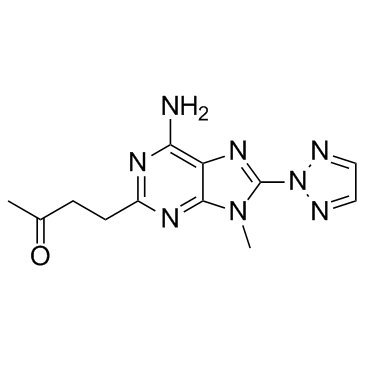ST4206 |
| Catalog No.GC31256 |
ST4206 is a potent and orally active adenosine A2A receptor antagonist, with Kis of 12 nM and 197 nM for adenosine A2A receptor and adenosine A1 receptor, respectively.
Products are for research use only. Not for human use. We do not sell to patients.

Cas No.: 1246018-36-9
Sample solution is provided at 25 µL, 10mM.
ST4206 is a potent adenosine A2A antagonist, with Kis of 12 nM and 197 nM for adenosine A2A receptor and adenosine A1 receptor, respectively.
ST4206 inhibits agonist-induced cAMP accumulation with an IC50 of 990 nM[1].
ST4206 (10, 20, and 40 mg/kg, p.o.) antagonizes haloperidol-induced catalepsy, and increases motor activity in a dose dependent manner in mice. ST4206 (20 and 40 mg/kg) significantly increases the number of contralateral turns induced by l-DOPA in rats[1]. ST4206 is orally active at concentrations of 10, 20, and 40 mg/kg in haloperidol-induced catalepsy in mice[2].
[1]. Stasi MA, et al. Animal models of Parkinson?s disease: Effects of two adenosine A2A receptor antagonists ST4206 and ST3932, metabolites of 2-n-Butyl-9-methyl-8-[1,2,3]triazol-2-yl-9H-purin-6-ylamine (ST1535). [2]. de Lera Ruiz M, et al. Adenosine A2A receptor as a drug discovery target. J Med Chem. 2014 May 8;57(9):3623-50.
Average Rating: 5 (Based on Reviews and 3 reference(s) in Google Scholar.)
GLPBIO products are for RESEARCH USE ONLY. Please make sure your review or question is research based.
Required fields are marked with *




















